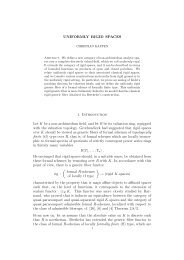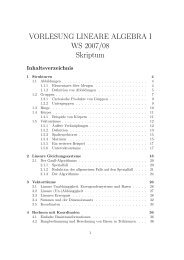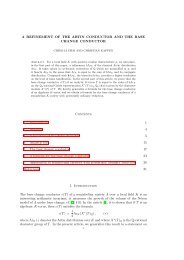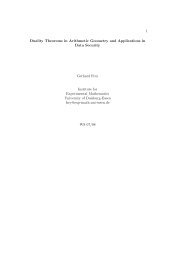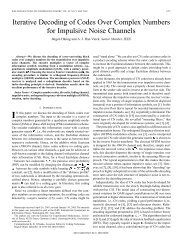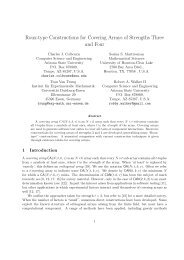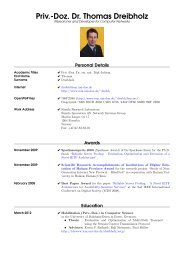ecause by part (a) we know that r E Hkis surjective if and only if p ∤ f EH .Now suppose that H is an ideal subgroup scheme. Since f EH |f E by (46), it followsfrom (62) that we have equality in the second part <strong>of</strong> (58). Moreover, since H = H(I)for some ideal I, we see from (59) that H k = H(r k (I)) is also an ideal subgroup. PutR = End(E). Since r k (R) = End(E k ), we obtain from Corollary 23 that [R : I(H)] =|H| = |H k | = [r k (R) : I(H k )], and so we must have equality in the first part <strong>of</strong> (58) aswell.Finally, to prove that equality holds in (58) when (|H|, p) = 1, we first observethat although the map H ↦→ H k is not injective in general, we do have(63)H 1 ≤ H 2 ⇔ (H 1 ) k ≤ (H 2 ) k , if (|H 1 |, p) = 1.To see this, recall first that we also have a reduction map r E(K)k: E(K) → E k (k)on the group <strong>of</strong> rational points and that by base-change this extends to a map r k :E(K) → E(k) whose kernel has no non-trivial points <strong>of</strong> order prime to p = char(k).We thus have an isomorphismr (p)k: E(K) (p)tor∼→ E k (k) (p)tor,where E(K) (p)tor denotes the group <strong>of</strong> torsion points in E(K) <strong>of</strong> order prime to p, andE k (k) (p)tor is defined similarly. Now if H is a finite group scheme <strong>of</strong> E with (|H|, p) = 1,then ˜H is an etale group scheme, and so we can identify H k ⊗ k and H ⊗ K withsubgroups <strong>of</strong> E k (k) and <strong>of</strong> E(K) <strong>of</strong> the same order and we have r (p)k(H ⊗K) = H k ⊗k.From this, the assertion (63) follows immediately, provided that also (p, |H 2 |) = 1.To prove it without this hypothesis, note that we can reduce the assertion to this caseas follows. Put n 1 = |H 1 | = |(H 1 ) k |. Since H 1 ≤ Ker([n 1 ]), we see that H 1 ≤ H 2 ⇔H 1 ≤ H 2 [n 1 ] := H 2 ∩ Ker([n 1 ])), and similarly, (H 1 ) k ≤ (H 2 ) k ⇔ (H 1 ) k ≤ (H 2 ) k [n 1 ] =(H 2 [n 1 ]) k . Thus, since p ∤ |H 2 [n 1 ]|, it follows that (63) is true.We are now ready to prove that equality holds in (58) when p ∤ |H|. Indeed,since f E(H) |n 2 f E by (27), it follows from (62) that equality holds in the second part<strong>of</strong> (58). To prove this also for the first part, let g ∈ I(H k ), so H k ≤ Ker(g). Sincer k : End(E) → End(E k ) is an isomorphism, there exists a unique g 1 ∈ End(E) suchthat r k (g 1 ) = g. By (60) we know that Ker(g 1 ) k = Ker(g), and so it follows from (63)that H ≤ Ker(g 1 ). Thus g 1 ∈ I(H) and so g = r k (g 1 ) ∈ r k (I(H)). This shows thatequality holds in the first part <strong>of</strong> (58) as well.3.2 The case K = CIn the case that K = C, every <strong>elliptic</strong> curve E/C has an analytic description, i.e. thereexists a lattice L ⊂ C and an isomorphism <strong>of</strong> compact Riemann surfaces E C ≃ C/L,where E C denotes the compact Riemann surface associated to the (algebraic) curve22
E. As we shall see, it is very illuminating to relate the previous constructions to thelattices appearing in the complex theory.To make this analytic description more precise, recall first that if L ⊂ C is anylattice, then the existence <strong>of</strong> the Weierstrass ℘-function ℘ L shows that the Riemannsurface C/L can be identified with a unique <strong>elliptic</strong> curve E L ⊂ P 2 (C) (given by theWeierstrass equation y 2 = 4x 3 − g 2 (L)x − g 2 (L)) and that we have an isomorphismρ L : C/L ∼ → E L (C)given by z + L ↦→ (℘ L (z) : ℘ ′ L(z) : 1) ∈ P 2 (C).Conversely, given any E/C, then E is isomorphic to a Weierstrass curve E ′ ⊂ P 2 (C),and for each such E ′ : y 2 = 4x 3 −ax−b there is a unique lattice L such that g 2 (L) = aand g 2 (L) = b; cf. Cox[7], p. 224. In particular, E L = E ′ ≃ E.Via this isomorphism we have a natural identification(64)Ψ L : (L : L) C = {λ ∈ C : λL ⊂ L} ∼ → End(E L )given by λ ↦→ π λ , where π λ = π L λ ∈ End(E L) is defined by π λ (ρ L (z +L)) = ρ L (λz +L);cf. [18], §1.4.From this one sees easily that E L is a <strong>CM</strong> <strong>elliptic</strong> curve if and only if (L : L) C ≠ Z.If this is the case, then (L : L) C is an order in some (unique) imaginary quadratic fieldF ⊂ C and L = λL 0 , for some lattice L 0 ⊂ F and λ ∈ C × . Since E L ≃ E L0 , we canand will henceforth assume that L = L 0 ∈ Lat F .If E L is <strong>CM</strong> <strong>elliptic</strong> curve with L ∈ Lat F , then its finite subgroup schemes H canbe identified with lattices L H ⊃ L, as we shall now see. Via this identification we candetermine I(H) and H(I) as follows.Proposition 26 Let L ∈ Lat F , where F is an imaginary quadratic field. For everylattice L ′ ∈ Lat F with L ⊂ L ′ , the group H L ′ = ρ L (L ′ /L) is a finite subgroup scheme<strong>of</strong> E L , and conversely every finite subgroups scheme H <strong>of</strong> E L is <strong>of</strong> the form H = H LH ,for a unique lattice L H ∈ Lat F with L ⊂ L H . Moreover,(65)(E L ) H ≃ E LH , E(H) ≃ R(L H ) and |H| = [L H : L].In addition, if I is a non-zero ideal <strong>of</strong> End(E L ), then we have(66)(67)I(H) = Ψ L ((L : L H )),H(I) = ρ L ((L : Ψ L (I))/L).Pro<strong>of</strong>. Since every finite subgroup scheme <strong>of</strong> E L is reduced (and etale), we can identifythem with the (abstract) finite subgroups <strong>of</strong> E L (C) ≃ C/L. Thus, if L ′ ∈ Lat F withL ≤ L ′ , then [L ′ : L] < ∞ and so L ′ /L is a finite subgroup <strong>of</strong> C/L. Clearly, everyfinite subgroup H <strong>of</strong> C/L has the form H = L H /L, for a unique subgroup L H withL ≤ L H ≤ C. Since L H ⊂ 1 n L, where n = |H|, it follows that L H ∈ Lat F .23
- Page 1: Products of CM elliptic curves1 Int
- Page 7 and 8: Indeed, if If is a kernel ideal, th
- Page 9 and 10: Indeed, by (18) we have I 1 f = I 2
- Page 11 and 12: Proof. To prove (29), let h ∈ Hom
- Page 13 and 14: 2.4 The quadratic caseWe now specia
- Page 15 and 16: ecause here f 2 |f 1 , so f = f 2 a
- Page 17 and 18: For this, put f = [R ′ : R], I =
- Page 19 and 20: From (54) we can conclude that(55)d
- Page 21: If H is any finite subgroup scheme
- Page 25 and 26: From this we see on the one hand th
- Page 27 and 28: Proposition 30 Let L ∈ Lat F , wh
- Page 29 and 30: (b) Deuring[10], p. 263. Note that
- Page 31 and 32: integral quadratic formq L,α,β (x
- Page 33 and 34: Corollary 39 Let E 1 /K and E 2 /K
- Page 35 and 36: Proof. Write π i = π Hi : A → A
- Page 37 and 38: (a) The order R is cyclic if and on
- Page 39 and 40: for k = 1, . . . , n − 2. Moreove
- Page 41 and 42: 4.3 Products of CM elliptic curvesW
- Page 43 and 44: Corollary 56 Let E/K be a CM ellipt
- Page 45 and 46: Case 2. char(K) = 0.As was mentione
- Page 47 and 48: Let h A/K (X) ∈ Z[X] (respectivel
- Page 49 and 50: Proof. To prove this, we shall use
- Page 51 and 52: where xy denotes the quadratic form
- Page 53 and 54: denote the set of isomorphism class



